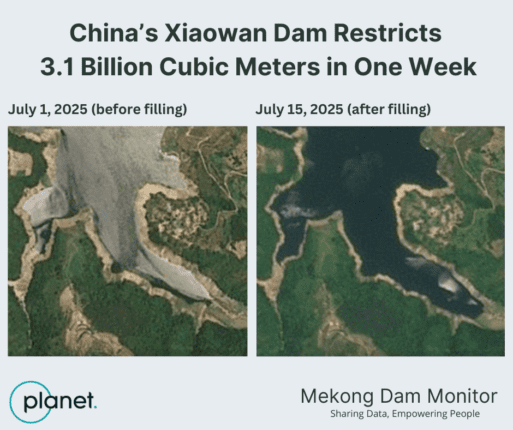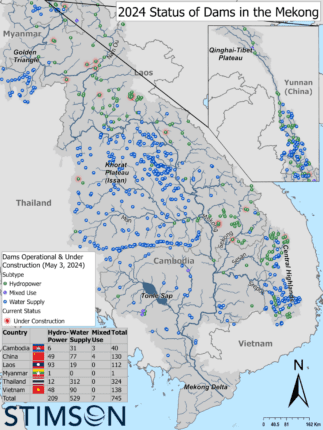-
The Mekong Dam Monitor Tracks a River Under Pressure
July 22, 2025 By Madelyn MacMurray
The Mekong River’s seasonal floods nurture the world’s most productive inland fishery and irrigate rice paddies that feed millions. Approximately 70 million people live in the lower Mekong Basin, and 75% of them depend on fishing and farming for their livelihoods. But hydropower expansion and other development projects are fragmenting the river and disrupting its natural rhythms, with severe consequences for those living downstream.
Farmers in Vietnam’s delta report worsening saltwater intrusion. Fishermen along the Tonle Sap Lake are seeing reduced seasonal expansion. In northern Thailand, sudden dam releases upstream are triggering floods without warning.
The Mekong Dam Monitor (MDM), launched in 2020 by the Stimson Center, was developed to help track these changes. Through a combination of satellite imagery, remote sensing, and GIS analysis, the MDM monitors 60 dams across the basin, offering near real-time data on water levels, dam operations, and sediment flows, and filling a critical data gap on the impact of water restrictions on the river’s ecological health. Its “virtual gauges”—which utilize satellite imagery and GIS analysis to remotely analyze water levels—provide information on fluctuations in the river’s flow, whether unexpected floods or droughts.

MDM analysis has revealed, for example, that China’s 12 dams on the Upper Mekong (or “Lancang” as it’s known locally) can hold back more than 20% of wet season flows, compounding drought conditions downstream. In Laos, the Xayaburi and Don Sahong dams are obstructing the fish migration routes that once connected the Tonle Sap to tributaries across the basin. The MDM also tracks how sediment, vital to agricultural productivity and ecosystem health, is being trapped behind dams.
Importantly, the MDM has become an early warning system for communities along the river. When satellites detect sudden water releases from Chinese dams, alerts are sent to Thai communities days before the surge arrives. “Before, the water would rise without warning,” said a boat operator when meeting with the project team in Chiang Khong. “Now we have time to secure our boats and move livestock.”
The MDM’s open-access data has also influenced policy discussions surrounding Mekong dams, pushing governments toward transparency, informing dam operation policies, and giving downstream nations independent evidence of upstream impacts. By providing an independent data source, the Mekong Dam Monitor fills key data gaps on the status of dam projects, while promoting transparency about dam operations.
Still, the tool has limits. The monitor currently tracks only a fraction of the basin’s 300+ dams. Its high-tech approach can be hard to access for the farmers and fishers who need it most. And while it documents impact, translating findings into political action remains a challenge. Overall, the data paints an unsettling picture: the Mekong’s natural pulse is weakening, and with it, the ecological foundation that supports millions of livelihoods.
As the Mekong faces the impacts of climate change and continued development, the MDM offers a critical evidence base—one that can inform decisions that might yet preserve the Mekong as a living river, not just a source of hydropower.
Sources: International Crisis Group.
Photo Credit: Mekong Dam Monitor.
 A Publication of the Stimson Center.
A Publication of the Stimson Center.








